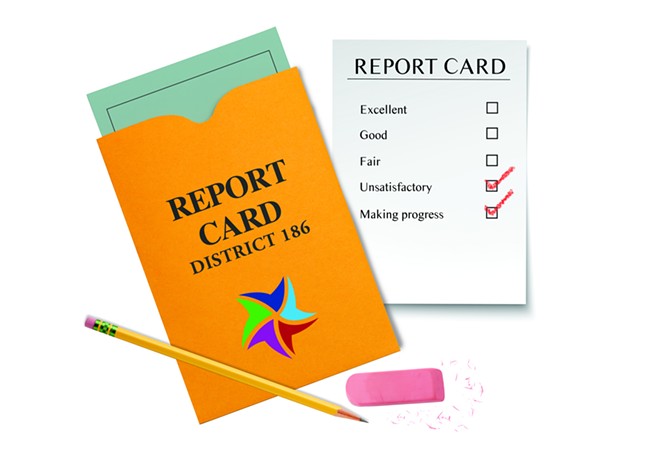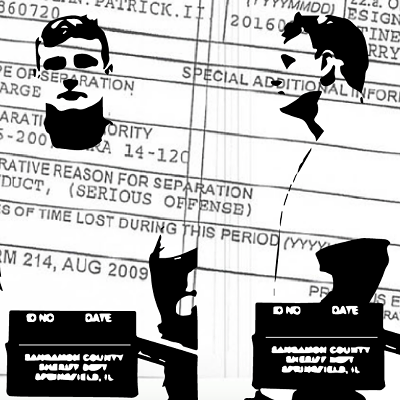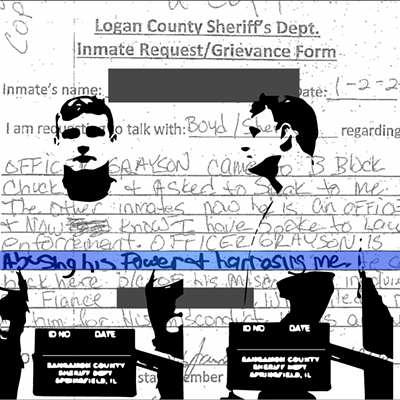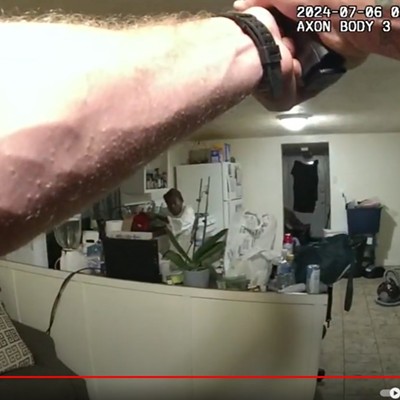The COVID-19 pandemic may be officially over, but its effects linger throughout the state's education system. That's one takeaway from the Illinois State Board of Education's (ISBE) 2023 Illinois Report Card, a detailed annual summary that shows how the state, and each school and district, are progressing on a wide range of educational goals, based on data from the 2022-23 academic year.
The educational symptoms of the COVID disruptions are still noticeable in Springfield School District 186, where the district generally did not perform as well as the state average in several categories on the ISBE Report Card. But District 186 officials note that progress is being made in key areas, and that upward trajectory is a better measure of what is occurring in Springfield's schools.
According to the report card, the chronic absenteeism rate for District 186 was 43 percent, versus 28.7 percent for Illinois. The district's four-year high school graduation rate was 62.5 percent, compared to 87.6 percent for Illinois, and only 69.3 percent of the district's ninth-graders were on track to graduate on time, as opposed to 87.4 percent of ninth-graders in Illinois.
The largest district-state disparity was in the student mobility rate, a measurement of students who moved into or out of any District 186 school during the school year. That rate was 15.7 percent for District 186 and 7.4 percent for Illinois.
The Report Card's Illinois Assessment of Readiness rating showed that 23 percent of District 186 third through eighth grade students who took the assessment were considered proficient in English Language Arts, versus 35 percent for the state's students as a whole. In math, 16 percent of District 186 students in those same grades were considered proficient, versus 27 percent for Illinois.
The ISBE also reports on growth toward proficiency, and the District 186 rate of growth in English Language Arts was at the 44th percentile, with the mean state average being 50th percentile. The district's math growth rate was at the 46th percentile. In 2022 those growth rates were at the 49th and 48th percentiles, respectively. These ratings show that District 186 students' proficiency rates are growing, but the overall rate of growth has slowed from the previous academic year.
Can the pandemic and its remote-learning disruption of the state's education system be blamed for all these numbers in District 186?
"Kids can't learn if they're not in school."
"We aren't happy with the overall outcome of some of our test scores and our attendance records," said District 186 Superintendent Jennifer Gill. "But it gives us a place to start anew."
One source of this unhappiness was chronic absenteeism, which the ISBE defines as those students who have missed 10 percent or more of the school year, regardless of whether it's an excused or unexcused absence. In an average District 186 classroom of 20 students, more than eight were chronically absent last year.
Gill pointed to COVID as the main culprit.
"After they returned to the classroom, if anybody had a symptom, we asked them to stay home. Many students got COVID and had to stay home between 10 and 23 days," Gill said. "These things were devastating to those students. They were on a road that nobody else had traveled."
Gill said many students were able to make up for lost classroom time through summer education programs, but the federal COVID recovery funds that paid for those summer schools will be expiring.
"You have to have four years of English to graduate and if you missed a whole year of English, you've got to make that up," Gill said.
Aaron Graves, president of the Springfield Education Association, the union representing District 186 educators, said COVID isn't the only place to lay blame for the report card scores.
"Allowing the effects of COVID to excuse our lack of achievement is something that we cannot support," Graves said. "Our union, teachers, parents, administrators, community and kids are all responsible for our data and, either we get the accolades, or criticism deserving of such."
Robin Steans is the president of Advance Illinois, a bipartisan education policy and advocacy organization. She is concerned about the chronic absenteeism rate in both District 186 and throughout Illinois.
"When you do poorly with attendance and absenteeism you can expect to see academics decline. Kids can't learn if they're not in school," Steans said. "When you dig into that, the rates for low-income, Latin and Black students are much higher, and disturbingly so. That is an alarm bell we all should be paying attention to."
The chronic absenteeism rate in District 186 for Black students was 51.5 percent, for Hispanic students it was 41.2 percent, and 34.3 percent for white students.
"People are working like crazy on this, it's getting a lot of attention and effort, but it's certainly a concern in Springfield, because their numbers are significantly higher than the state's, as are many urban areas," Steans said. "When you see absenteeism numbers improve, that's usually an indicator that academic numbers will improve."
Gill said that District 186 has hired staff at its schools whose primary job is to reduce absenteeism by removing barriers to student attendance and making students want to come to school.
"Making up lost academic ground is hard work."
District 186 students who graduated from high school in 2023 were freshmen when the COVID-19 pandemic hit. About one-third of their fellow students who were with them in March 2020 didn't receive diplomas last spring.
"Some students got so off track with their graduation credits that they would not be able to make them up," Gill said. "And there are going to be kids coming up who are struggling as well, so we can't let up our pace of trying to provide external supports to help students get through."
Gill pointed to ongoing efforts at Lanphier High School as evidence that the district is attacking the graduation rate problem. A seasoned administrator was hired to focus on 90 students who were not on track for graduation after ninth grade. That administrator was able to move 45 of those students back on track by the end of their sophomore year. Similar administrative positions have since been added at Springfield High School and Southeast High School.
Gill also said an important thing to examine is whether students graduate from high school, not how long it takes them to do it.
"We have students who graduate after five years that we are keeping in our high schools and providing with the right supports so they can get their degree," Gill said. "If you go to college and you take five years because you change your major, nobody thinks anything about that. But in high school if you don't get it done in four years, it's billed as something's wrong."
"There are 75 students right now at Lanphier who are finishing up their degrees but didn't graduate in four years," Gill said. "I congratulate those 75 who are sticking with it. Our school district didn't forget about them and we are providing the support they need to graduate."
The Springfield Education Association's Graves cautioned against trying to push students through, just to satisfy graduation rate figures.
"In the past, we continued to move students onto the next grade level, year after year, without mandatory academic interventions," Graves said. "There must be concrete academic cut points for all students and honest discussions with parents about their child's progression. Making up lost academic ground is hard work, and only tough discussions and decisions will lead us elsewhere."
Steans of Advance Illinois said she's encouraged that the District 186 administration is "owning" their report card numbers and is doing something to improve their graduation rates.
"The report card shows you where you are making progress and where you have trouble spots," Steans said. "That is exactly the response that parents should hope for from their school leaders."
Steans said that data collected by Advance Illinois shows a bright spot for District 186 in the years to come.
"We have a kindergarten readiness assessment that tells us how kids are looking going into kindergarten, and the kindergarten readiness numbers for Springfield went up significantly," Steans said. "If kids are coming into school in a stronger place, that's a really good sign."
"Can't be successful if the mobility rate stays that high."
Springfield's public schools had twice as many students enter or leave schools in the district last year than the average Illinois school district.
The mobility rate is particularly high at Southeast High School, where one-fourth of the students have come from another school at some point in their educational journeys.
"We have about 200 kids who have moved more than three times in their high school careers. They can't be successful if the mobility rate stays that high," Southeast Principal Cody Trigg said. "A good portion of our kids who struggle have hopped schools, and that is often something the families cannot control because it may be driven by job or other external situations."
Superintendent Gill said the mobility rate is something the district can't control, but it's a unique challenge that still must be faced.
"District 186 has a pretty high percentage of mobility and we have new kids coming to us all the time, so it's a struggle for sure," Gill said. "All of us would like to be measured by our successes rather than our failures, but this is one variable we can't control."
By contrast, Springfield's teachers are less mobile than their counterparts throughout the state, with 92 percent of them staying put last year. But the Springfield Education Association's Graves questions whether those teachers are being placed where they are most needed.
"District 186 has five percent more short-term or provisional teachers at our high poverty schools than the state average," Graves said. "We could remedy this by incentivizing experienced teachers to work at our neediest schools instead of at the most affluent schools, where most experienced teachers eventually gravitate."
Steans of Advance Illinois agreed that teachers often aren't placed where they are most needed.
"Schools with high teacher vacancy rates disproportionately serve low-income and Black students," Steans said. "That can impact how programs play out in the building, like you keep canceling gym or art or library because those teachers are covering other classes. That makes it harder to engage students and get them back into the habits and norms of coming to school every day."
Gill said it's not that simple, because teachers choose where they want to work.
"When teachers are hired, they are hired at a particular school, and they have an opportunity through a voluntary transfer program to move to another school and be interviewed for a position there," Gill said. "I have trust in every teacher in this district. But I also know they have different needs too and they need different kinds of professional development at different times during their careers."
Illinois Superintendent of Education Tony Sanders said the state's evidence-based funding formula has helped to place more teachers where they are needed in the state's public schools. But he said there is still a disparity in some districts, like Springfield, where not enough teachers are available for schools in economically disadvantaged areas.
"We educate Black students disproportionately in underfunded schools that have more teacher vacancies, higher teacher and principal turnover, higher chronic absenteeism," Sanders said. "So our Black students in general have less access to supports, to the resources they need to learn at the rate to be on par with their peers."
Despite that disparity, Sanders noted that Black students saw the biggest gains in proficiency rates on the most recent state report card, a 33 percent increase over the previous year. According to Gill, Black students in District 186 had a three percentile increase in baseline academic growth in literacy from 2022 to 2023 and those in high school showed a five percent growth on the Scholastic Aptitude Test (SAT).
"Our definition of equity is giving all students what they need when they need it," Gill said.
Gill and all four of the school principals interviewed for the accompanying story unhesitatingly said they "own" the ISBE Report Card numbers and are committed to improving those metrics in the future.
"This report card is a gut punch, it makes you feel bad, but wait, look at all of the successes we had this year," Gill said. "The report card provides us with a sense of urgency, with data that we can utilize to help plan our school improvement efforts."
The report card ratings
The Illinois State Board of Education ratings of Springfield School District 186 schools for the 2022-2023 academic year are listed below.
The ranking criteria listed on the State Board website includes:
Exemplary – Schools performing in the top 10 percent of schools statewide with no underperforming student groups. No District 186 schools were listed as Exemplary.
Commendable – A school that has no underperforming student groups, a graduation rate greater than 67 percent, and whose performance is not in the top 10 percent of schools statewide. A total of 17 District 186 schools were listed as Commendable.
Targeted – A school in which one or more student groups is performing at or below the level of the “all students” group in the lowest performing five percent of schools.
Three District 186 schools were listed as Targeted.
Intensive – A school that has completed a full Comprehensive Support school improvement cycle, but whose performance remains in the lowest-performing five percent of Title I eligible schools in Illinois or is a high school that has a graduation rate of less than 67 percent or less at the end of the four-year improvement cycle. Four District 186 schools were listed as Intensive. Comprehensive – A school that is in the lowest-performing five percent of schools in Illinois and any high school with a graduation rate of 67 percent or less. Six District 186 schools were listed as Comprehensive.
Commendable
Black Hawk Elementary School, Butler Elementary School, Edwin A. Lee Elementary School,
Elizabeth Graham Elementary School, Enos Elementary School, Iles Elementary School, Laketown Elementary School, Lincoln Magnet School, Lindsay Elementary School, McClernand Elementary School, Owen Marsh Elementary School, Ridgely Elementary School, Sandburg Elementary School, Southern View Elementary School, Springfield Ball Charter School, Springfield High School, Wilcox Elementary School
Targeted
Benjamin Franklin Middle School, Hazel Dell Elementary School, Jane Addams Elementary School
Intensive
Feitshans Elementary School, Harvard Park Elementary School, Jefferson Middle School, Washington Middle School
Comprehensive
DuBois Elementary School, Fairview Elementary School, Lanphier High School, Matheny-Withrow Elementary School, Southeast High School, U.S. Grant Middle School
More stats from the District 186 report card include:
• Average class size 20.
• A total of 12,911 students in the district, of which 4,762 were white, 5,676 Black, 463 Hispanic, and 347 Asian.
• Teacher retention rate 92.9 percent versus 90.2 for Illinois.
• Student-administrator ratio 129 versus 141 for Illinois.
- David Blanchette
























